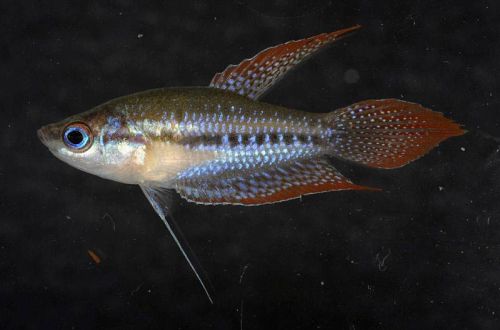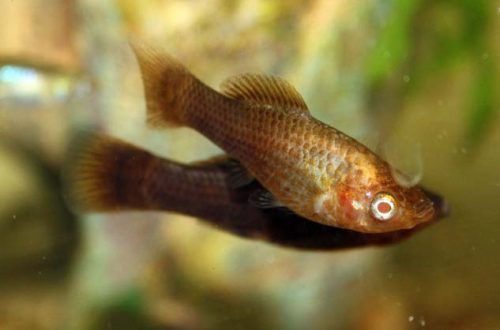
Moscow guppies
Moscow guppies or Guppy Moscow (synonym), scientific name Poecilia reticulata (variety Moscow), belongs to the Poeciliidae family. Among Russian breeders, representatives of the old Soviet school, these names mean red-colored fish with large fins and a veiled tail.
The old school is not mentioned by chance. A new generation of aquarists and breeders have adopted the European idea of how the “Moscow Guppies” should look – these are fish with a solid dark blue color.
The reasons for the resulting confusion are described below in a small historical note.
Brief information:
- The volume of the aquarium – from 40 liters.
- Temperature – 17-28°C
- Value pH — 7.0–8.5
- Water hardness – soft to high (10-30 dGH)
- Substrate type – any
- Lighting – moderate or bright
- Brackish water is permissible in a concentration of up to 15 g per 1 liter
- Water movement – light or moderate
- The size of the fish is 3–6 cm.
- Food – any food
- Temperament – peaceful
- Content alone, in pairs or in a group
Maintenance and care

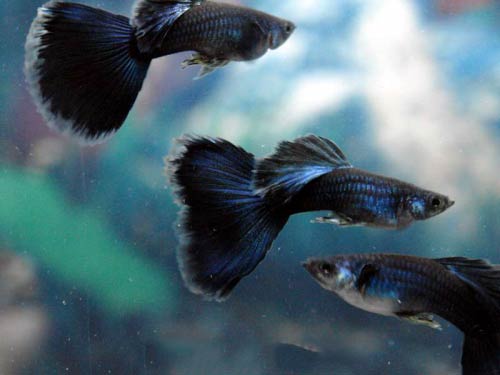
They are distinguished by good endurance and unpretentiousness to the environment. Successful long-term keeping depends on the right choice of neighbors, regular feeding and timely maintenance of the aquarium. The latter includes the prevention of installed equipment and the weekly replacement of part of the water with fresh water, which is usually combined with the removal of organic waste (feed residue, excrement) using a siphon. The newly added water should have a similar temperature, while the hydrochemical composition will not play a significant role.
It is worth remembering that any artificially bred breed can interbreed with other strains and produce hybrid offspring. Given the rate of reproduction, Guppies are more likely to degenerate if they are in the company of other varieties.
History “Guppy Moscow”
In the USSR, the borders were closed. There was no exchange of experience between Soviet and foreign aquarists, so the evolution of guppies on the territory of the Soviet Union took place isolated from the rest of the world. This has led to the emergence of unique strains unknown in Western countries.
Back in 1954, there were only a few breeds, one of them was the Moscow Round-tailed. No photographs have been preserved, there are only a few verbal descriptions. For example, one of the leading breeders of that time, N. A. Vasilyev, described it as follows:
“A medium sized fish. There is a bright red spot at the base of the tail. Sometimes it has orange streaks. The second oval red spot is located on the back in front of the dorsal fin. On the back of the body near the gonopodium there is a noticeable green spot, which is sometimes decorated with a black bean-shaped dot. The same spot is located under the dorsal fin. A dark stroke extends from the eyes to the middle of the body. The tail is rounded jet black with colored speckles. There can be a lot of specks, from which the tail becomes silver or red.
Soviet Guppies
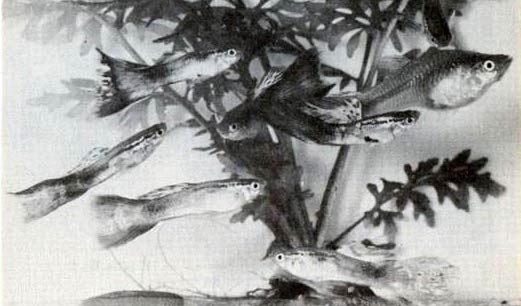 A black and white photograph from 1954 – an aquarium with guppies from the era of the Soviet Union
A black and white photograph from 1954 – an aquarium with guppies from the era of the Soviet Union
In 1962, another well-known Soviet breeder, F. M. Polkanov, already counted 24 varieties. All of them differed in color, body pattern and tail shape. Each was given its own name. The word “Moscow” began to be used for breeds that have a different tail shape than a round one, for example, forked, train, spear-tailed, scarf.
Due to the variety of colors and body patterns, the shape of the tail was the only reliable criterion for classification, which formed the basis of the “Guppy Standard” adopted in the USSR. The word “Moscow” fell out of use for a while
In 1983, the Moscow Club of Aquarists and Terrariumists was formed, bringing together leading Soviet and then Russian breeders. The club arranged annual exhibitions and was engaged in active selection. In the 1990s, the concept of “Moscow” was again introduced into use, by which they understood uniformly colored red guppies with large veiled tails.
Classic Red Moscow Guppy
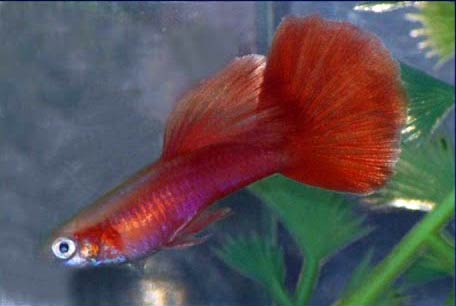 Moscow red guppy from breeder Vyacheslav Kornev, 1970
Moscow red guppy from breeder Vyacheslav Kornev, 1970
It is worth noting that in Europe and America, completely different fish with a solid dark blue color are supplied under the name “Guppy Moscow Blue”. The confusion arose in 1998 and is related to the third International Guppy Competition in Milwaukee (USA). That year, the jury gave its votes to unusual fish from the collection of Japanese breeders, acquired earlier in Moscow from one of the local breeders. At the competition, the Japanese presented these fish as “Guppy Moscow”, thereby indicating their geographical origin (place of purchase). They did not know anything about the classification adopted in Russia and that this name is already used in relation to other breeds.
The activities of the Moscow Club of Aquarists and Terrariumists began to decline after the financial crisis of 2008. The exhibition organized in 2009 turned out to be the last one. A serious blow to private fish collections was dealt by the abnormal heat of 2010, which covered all of Eastern Europe. According to some reports, from 50 to 80% of the unique Guppy strains were lost.
In 2011, the Club ceased its activities, at that time there were over 300 breeds in its catalog. Since then, breeding activity in Russia has declined. The continuity between old and new breeders is broken, and the new generation of aquarists increasingly perceives Guppy Moscow Blue as truly Moscow.



